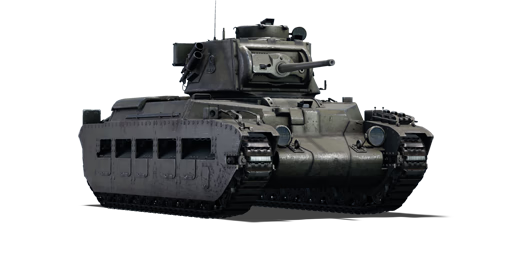

Ground Vehicles
Matilda III
II
Rank
AB
2.7
RB
2.7
SB
2.7
Battle rating
Great Britain
Research country
Heavy tank
Main role
9,200

Research
16,000

Purchase
General information
The Matilda III (or just Matilda III) is a British heavy tank. It was introduced in Update 1.55 "Royal Armour" along with the rest of the initial British Ground Forces Tree. The Matilda III in the game reflects its real-life counterpart with its extreme slow speed, but formidable front armour.
The Matilda is a great character on the battlefield. The name and its historical significance makes the Matilda a more noteworthy target than your teammates. The Matilda should be played like most other heavy tanks, absorbing damage for your team mates and dealing damage against the enemy as they try to penetrate your armour. Stay away from the front line to maximise armour effectiveness with distance.
Camouflages
Survivability and armour
Armour
front / side / back
Hull
75 / 70 / 55 mm
Turret
75 / 75 / 75 mm
Visibility
83 %
Crew
4 persons
Support systems
Mobility
Max speed
Forward
2426 km/h
Backward
4 km/h
Power-to-weight ratio
7.56.611.99.6 hp/t
Engine power
190168302245 hp
Weight
25.4 t
Optics
Gunner
Commander
Driver
Optics zoom
1.9x–3.5x
—
—
Armaments
40 mm QF 2-pounder cannon
Ammunition
93 rounds
Reload
basic crew → aces
3.6 → 2.8 s
Vertical guidance
-20 / 20°
Turret Rotation Speed
basic crew → aces
Horizontal
1411.922.416.2 → 20173223.1 °/s
Vertical
10.58.427.317.5 → 15123925 °/s
| Ammunition | Type | Armor penetration (mm) at a distance: | |||||
|---|---|---|---|---|---|---|---|
| 10 m | 100 m | 500 m | 1000 m | 1500 m | 2000 m | ||
| AP | 72 | 68 | 52 | 37 | 27 | 19 | |
| HE | 9 | 8 | 7 | 6 | 6 | 5 | |
| APCBC | 89 | 86 | 77 | 66 | 57 | 50 | |
| AP | 80 | 75 | 58 | 41 | 30 | 21 | |
| APHE | 66 | 62 | 49 | 36 | 26 | 19 | |
7.92 mm BESA machine gun (coaxial)
Ammunition
4,050 rounds
Belt capacity
225 rounds
Reload
basic crew → aces
10.4 → 8 s
Fire rate
600 shots/min
| Belt | Belt filling | Armor penetration (mm) at a distance: | |||||
|---|---|---|---|---|---|---|---|
| 10 m | 100 m | 500 m | 1000 m | 1500 m | 2000 m | ||
| AP-I/AP-I/AP-T | 9 | 8 | 6 | 3 | 0 | 0 | |
Economy
Repair cost
Basic → Reference
AB
867 → 1,125 

RB
884 → 1,147 

SB
1,149 → 1,491 

Crew training
4,500 

Experts
16,000 

Aces
160 

Research Aces
190,000 

Reward multiplier
AB / RB / SB
40 / 60 / 60 % 

118 % 

Total cost of modifications
8,430 

9,430 

Talisman cost
640 

Research order:
Mobility | |
|---|---|
Protection |
|---|
Firepower | |
|---|---|
Rating by players
You must play more than 3 battles for the last week and more than 10 battles in a vehicle to rate it.
Like:
42
Armor protection:
Not enough ratings
Survivability:
Not enough ratings
Mobility:
Not enough ratings
Armament:
Not enough ratings
Balance:
Not enough ratings
Tips & Tricks
This space is currently empty
Do you know any interesting vehicle features?
Loading...
No articles about this vehicle yet
Become the first author and get rewards!
Write a guide, tell about interesting historical facts, make a tutorial or simply an interesting post.
No more content